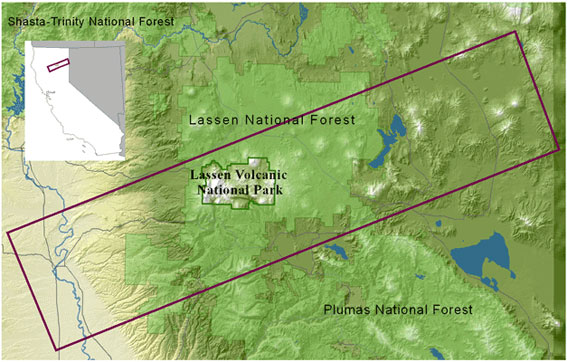Lassen Transect

The “Lassen Transect” is a 3,000 square mile swath of northern California running from the Sacramento River to the Nevada border. Within the transect are a wide variety of habitats, including the grassy plains and oak foothills of the Central Valley, dense conifer forest, subalpine peaks and meadows, glacial lakes, sagebrush flats and high desert. Notable features within the transect include all of Lassen Volcanic National Park and Eagle Lake, large sections of the Lassen National Forest and Tehama Wildlife Area, and portions of the Great Basin ecological region.
The Lassen Transect was originally surveyed from 1924 through 1929 by Joseph Grinnell, the founding Director of the MVZ, and his colleagues Joseph Dixon and Jean Linsdale. They visited more than 50 sites throughout the region, documenting the distributions of more than 350 species of birds, mammals, reptiles and amphibians, and collecting more than 4,500 specimens. They summarized their results in the 1930 monograph entitled “Vertebrate Natural History of a Section of Northern California through the Lassen Peak Region.” More than just a species checklist, this 600-page volume is rich with behavioral observations and historic photographs. For many areas in the transect, their survey remains the most comprehensive vertebrate inventory yet conducted. Their specimens are still at the MVZ and are still being used for wide variety of scientific research projects.
The resurvey of the Lassen Transect began in the summer of 2006 and ran for three years. Resurvey efforts include inventorying the local bird, mammal, reptile and amphibian species; collecting a few representative samples of each species as museum specimens; taking extensive notes on the local habitats; and re-photographing specific sites that were photographed 85 years ago by Joseph Grinnell and his colleagues. The surveys in the Lassen Transect will be important for determining whether the species range shifts recently documented in the Yosemite Transect are occurring throughout the state. This project will also build upon local species inventory and monitoring efforts by the National Park Service, US Forest Service, California Department of Fish and Game and the Bureau of Land Management, providing important information to assist with the management and conservation of California's rich wildlife heritage.


